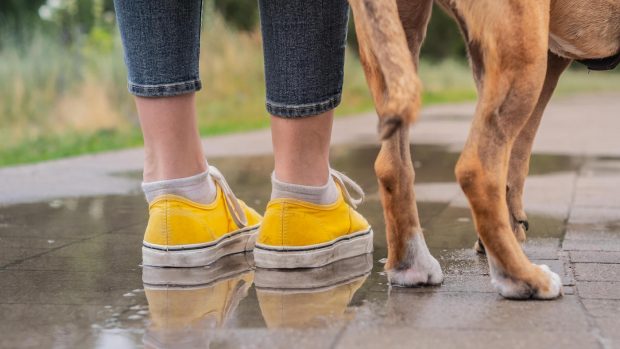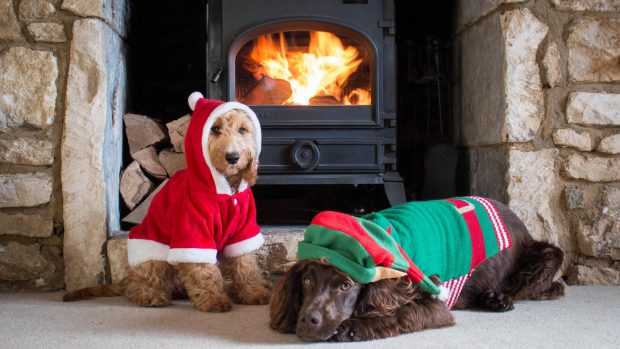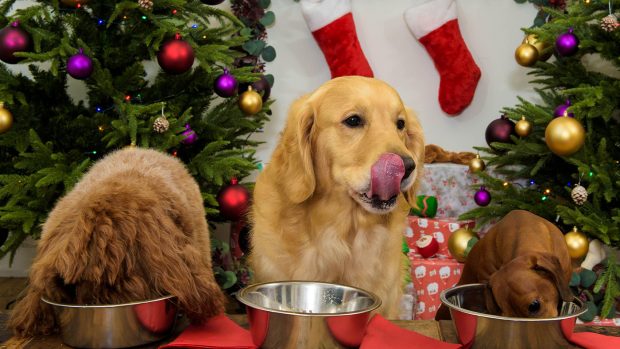The first thing you need to know about how to stop a dog begging is that all dogs are opportunists and will try their luck. Some breeds are particularly proficient, such as Labradors, beagles, Cavalier King Charles Spaniels and dachshunds.
In short, to stop a dog begging you need to give no eye contact, use the correct body language, set behavioural expectations and routine. Let’s break things down as to why dogs beg, how to stop a dog begging and find out what you can put in place to create good habits and what you can stop doing to exacerbate the behaviour.
Why do dogs beg?
Well, the reason is straightforward and obvious. What we eat smells delicious, is usually forbidden and, even if they are fed the best dry dog food, it is much more appetising than what is put in their bowl. Below are a few more reasons dogs exhibit this behaviour.
Food-seeking behaviour
Dogs are natural scavengers and food seekers; they have evolved this way to survive. While food is not withheld and is plentiful in most circumstances, it is still innate in their genetic make-up to scavenge to attempt a bin raid, a smash-and-grab of an unattended plate or hoover the kitchen floors in search of crumbs.
Reinforcement
If a dog has been rewarded – even inadvertently – for begging in the past, they may continue to do so in the future. This could happen if a dog sitting and watching you while you eat, then is either hand feed the leftovers from your plate or, worse, given the plate to finish it off. If you sit around the table and you feed bits of food to the dog while at the table, this is what is called a negative reward. The unwanted behaviour of begging has been affirmed the moment you gave them the food from your plate.
Attention-seeking behaviour
Dogs may also beg for food to get attention from their owners. If you have tried to correct the dog while looking at it at the same time, the begging has garnered your attention – it doesn’t matter whether it’s negative or positive, either way its attention. An example of positive attention is if you react to begging, then send the dog away and reward it immediately, he will learn to do the same behaviour again to get your attention, behave as instructed and voilà your dog receives the reward.
Anxiety or stress
This is highly unusual as a stressed or anxious dog usually does not want to eat, however, comfort eating may be a calming behaviour for some dogs, which is why Kong’s and lick mats are useful for helping an anxious dog.

Kong Toy | Amazon.co.uk
Available in a range of sizes, this toy can be stuffed with something tasty to keep your dog occupied.

Lick Mat | Amazon.co.uk
Keep your pup occupied with these lick mats that feature suction cups to keep them still.
Health issues
If a dog has been denied food, starved or is malnourished as a result of being fed a poor diet, then begging is likely to occur because they will not rationalise that they will be fed routinely and that food will never be withheld.
Instinctual behaviour
Dogs beg because it is a natural behaviour, as if they were scavengers in the wild.
It works
Dogs beg because it works and they get what they want. There is only you, the owner, to blame for that.
How to stop a dog begging: prevention
It’s actually quite easy and the simple solution is do not give your dog a direct gaze when you are eating. If mine gather round me, sit and stare, I put my leg out to keep them out of my personal space and they get no emotion from me whatsoever. Do not allow them under the table while you are eating, or even in the same room if possible. whether you have dinner on a tray in front of the TV or seated at a dining room table, you should never give your dog your food in that dining scenario.
Context is important when it comes to begging behaviour. If your dog understands that food on your plate eventually means food for him, particularly if he gives you whiny encouragement, he will view that context as mealtime for two. Keep in mind that a begging habit can also develop when you share snacks on the go, like when you are standing at the counter eating a few chips. If your dog demands some and you give in, you’ve trained your dog that begging works any time you are consuming food, which is the negative reward scenario again.
You can also prevent the behaviour by keeping your dog occupied while you eat. Setting your dog up on a nearby bed with a treat-stuffed puzzle toy will give him something to focus on other than the delicious smells wafting from your plate. Keep in mind that you will have to pack the toy so that it keeps your dog’s attention for the duration of your meal. A single treat will disappear in minutes, but a toy packed with goodness (including some of your dog’s meal ration) will hold his attention until you’ve finished. Freezing goodies in the toy with some dog-safe peanut butter cement will help slow the process, too. You can also feed your dog before you eat your meal.

Outward Hound Nina Ottosson Puzzle Toys | Amazon.co.uk
Choose from 31 puzzle toys across four levels of difficulty to exercise your dog’s mind and keep him stimulated.
How can you change begging habits
You need to be consistent with your training and expectations when human food is around. You have a tougher job if your dog already has a well-established begging habit.
The first rule for getting rid of it is completely ignoring your dog’s attempts to sweet talk his way to a titbit. This might seem simple, but the reality is your dog will go through what is called an “extinction burst” as he tries to get his formerly successful begging techniques to work. your dog will whine louder, paw harder and pace faster, since those tricks used to work to score some food. Keep the faith and trust that if you never give in as your dog escalates his requests, he will eventually abandon the begging. Do not give in to his new and improved begging strategy because this will teach your dog to never stop trying and that you will eventually cave if he pushes hard enough.
Much like with the prevention, keeping your dog busy while you eat will shift the focus from what’s out of reach on your plate to what’s right in front of his nose. Use a treat-stuffable hard plastic toy (such as a Kong, available from Amazon) or a lick mat (also available from Amazon) to give your dog a job that will keep him happily occupied. Consider using a one of the best puzzle toys that requires movement to dislodge the goodies, like a ball with holes that he has to push around the room. This will keep him away from your food zone while you eat.

Zellar Treat Dispenser Toy | Amazon.co.uk
Adjust the openings of this puzzle toy to challenge your dog’s problem-solving skills, providing interactive training, reducing boredom and destructive behaviour.

Outward Hound Nina Ottosson Puzzle Toys | Amazon.co.uk
Choose from 31 puzzle toys across four levels of difficulty to exercise your dog’s mind and keep him stimulated.

Kong Toy | Amazon.co.uk
Available in a range of sizes, this toy can be stuffed with something tasty to keep your dog occupied.
If your dog opts to get right up in your business while you dine, such as placing his nose in your lap, I suggest standing up and remove the dog from your personal space with body language i.e. walking right at the dog to make it move.
A quick and easy management technique is a tether to keep him away. This is a four to five foot lead that you anchor to a heavy piece of furniture, which is like a “stay” command with reinforcements. But remember that you still have to give your dog a job while you eat, as few beggars will watch you eat “their” food without barking or whiny commentary. As always, a treat-stuffed toy will help ease the transition from beggar to worker.
If you cannot resist sharing food with your pup, there is a way to make it happen without encouraging an obnoxious begging habit. You can train your dog to go to a specific spot and wait quietly until you are ready to offer him a taste. This lesson encourages impulse control and shows your dog that he does not have to be right on top of you acting pushy to get a bite. Train your dog to go to his bed or a nearby rug and wait until you are ready to give him a bit of apple or that last nibble of carrot. That way you’re both happy – your dog gets his goody and you get a polite dining companion.
You might also like:

How to stop a dog barking at the fence

No more yapping: how to stop a dog nuisance barking

How to stop your dog chewing your home to shreds

How to stop your dog licking their paws: advice from an expert

How to stop a dog peeing in the house

How to stop a dog digging in the garden: advice from an expert

How to help an anxious dog

Subscribe to Horse & Hound magazine today – and enjoy unlimited website access all year round
Horse & Hound magazine, out every Thursday, is packed with all the latest news and reports, as well as interviews, specials, nostalgia, vet and training advice. Find how you can enjoy the magazine delivered to your door every week, plus options to upgrade your subscription to access our online service that brings you breaking news and reports as well as other benefits.




